01dragonslayer
Ripped
- Jacked Cash
- 472,880
There are two schools of thought when it comes to taking training advice from the pros. Some insist that these men are, essentially, genetic mutants who respond so spectacularly to weight training that they have nothing of value to offer the rest of us mere mortals.
Others agree that these men might be genetic mutants, but they note that these guys competed against men who had comparable genetic gifts. To reach the winner's podium, these superheroes had to train harder and smarter than their rivals, which sounds a lot like what most of us still have to do today.
In other words, maybe these guys have something to teach us after all.
Many of the champions of yesterday and today have either developed their own exercises to address specific training issues, or have made certain exercises famous because of the gains they produced. Here are eight examples of training developments and modifications from across the decades. Though they come from the high and mighty, they just might work for you.
Yates was never content to simply mimic what others did. Having studied muscle anatomy and function, he concluded that the biceps were in their strongest pulling position when fully supinated. Biceps were already considered a weak link during any type of pulling for the back, he reasoned, so why not at least put them in their most mechanically powerful position. And so the underhand barbell row was born.
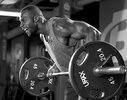
The movement might never have become so popular were it not for the fact that Yates' back development set an entirely new standard in density, width, thickness, and detail. Everyone wanted to know how he trained his back. Yates chalked it up to the underhand barbell row and before long, lifters had flipped their hands over for rows.
Lifters have always done weighted dips one of two ways: With a dumbbell or plates attached to a "dipping belt" chain around their waist, or by doing the dips between two benches with their feet elevated and plates stacked on their laps.
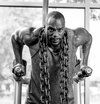
Warren's idea was to drape enormous chains around his hulking neck and traps to more evenly distribute the resistance, as well as to make drop sets much easier by just removing a chain once he hit failure.
Warren did these chains dips as part of his chest workouts, usually with his training partner Johnnie Jackson. Warren found that the chains naturally pulled his torso forward, which put more stress on his chest. Since both Warren and Jackson own two of the thickest sets of pecs seen in modern times, it wasn't long before gym rats began doing chain dips too—and making their own pecs thicker and denser.
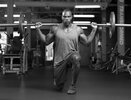
By the time Coleman dumps the iron off his back, his 34-inch, snake-veined thighs were pumped to high hell and looking good. Naturally, thousands of macho men, who before would never have been caught dead doing lunges, were suddenly into them. You could see these guys striding in full glory across gym floors and parking lots trying to make their thighs as massive as this then-reigning Mr. Olympia. Lunges weren't for sissies—they were for beasts!
In photos, it appeared as if Haney was doing a shrug behind his back, but in interviews he explained that it was, in fact, a behind-the-back barbell upright row. He liked this lesser-known movement because it recruited not only the upper portion of the traps, but also the lower region going down to the mid back, along with the rhomboids and rear delts.
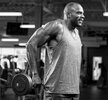
Even if you do only the shorter shrugging motion instead of the full upright row, you'll feel the movement lower down in the traps more than you would with standard shrugs.
Arnold worked hard on his deltoids to bring his shoulders up to snuff. Part of that workout included movements that stimulated his delts in new ways and shocked them into growth. His Arnold press was one such movement.
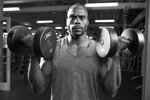
Regular presses push weight up and down. Arnold presses add hand rotation to the equation. He would start his namesake press holding the dumbbells with his palms facing his body. As he pressed the dumbbells, he would pronate (turn his wrists inward) and finish at the top with his palms facing forward, before returning to the starting position. This twist of the wrist incorporates a function of the deltoids normally not used in a press, making his version much more effective.
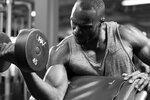
Not for a minute would I suggest that preacher curls alone gave Larry his 20-inch guns. He clearly had good genetics on his side, and any type of curls would have built his biceps to impressive size. But preacher curls are perhaps the only way those of you with dominant shoulders will ever achieve your full potential in biceps mass.
Preacher curls lock the upper arms in place and make it impossible for the front delts to take over the movement, as they often do with standard barbell or dumbbell curls. Curling with the arms braced will force your biceps to do the work—and reap the rewards.
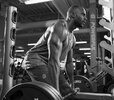
Henry was the first Olympia champion in the early days of the IFBB's 202 class (now 212). He was also the most successful proponent of DC training. Dante Trudel developed the DC system which featured more than a few unique exercises or variations on existing exercises, as well as liberal use of the rest-pause technique.
One of the main DC back movements is the "rack pull," a deadlift done in a power rack and pulled from just below the knees rather than from the floor. Shortening the range of motion effectively made this a real back exercise, instead of a movement for the back and legs.
Henry became known as "The Giant Killer" for consistently beating taller and heavier men. So renowned was his astoundingly thick and detailed back that people naturally wanted to know how he trained it. In several interviews and articles, Henry divulged his secret: very heavy rack pulls—as in 700-800 pounds. It wasn't long before bodybuilders starting switching out deadlifts for true back-day rack pulls.
But the problem with seated overhead presses of any type is that it's too easy to arch your lower back excessively and lean back. This positioning turns the overhead press into more of a steep-angle incline press for the chest. And while doing these presses seated might seem safe, the exaggerated arching of the back turns them into lower-back strains waiting to happen.
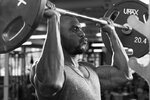
IFBB pro "Diesel" Morel has some of the widest, roundest shoulders in the sport today. Years ago, in a crowded gym, he got sick of waiting for a seated shoulder-press bench and decided to try standing presses with a barbell instead. From that first set, he was hooked. He found that performing his presses while standing forced his shoulders to work much harder as they struggled to balance the weight throughout the set.
Since that day, Diesel has done his presses standing—which was actually how bodybuilders used to do them in the old days. Thanks to various training articles and videos, other lifters learned about this form of pressing and liked the way the standing position led to better form and more deltoid growth.
Others agree that these men might be genetic mutants, but they note that these guys competed against men who had comparable genetic gifts. To reach the winner's podium, these superheroes had to train harder and smarter than their rivals, which sounds a lot like what most of us still have to do today.
In other words, maybe these guys have something to teach us after all.
Many of the champions of yesterday and today have either developed their own exercises to address specific training issues, or have made certain exercises famous because of the gains they produced. Here are eight examples of training developments and modifications from across the decades. Though they come from the high and mighty, they just might work for you.
1. Dorian Yates: Underhand Barbell Row
Barbell rows had been around for at least a half century before Yates won his first Mr. Olympia title in 1992. But as far as I can tell, no one had ever deviated from the standard overhand grip until Yates came along.Yates was never content to simply mimic what others did. Having studied muscle anatomy and function, he concluded that the biceps were in their strongest pulling position when fully supinated. Biceps were already considered a weak link during any type of pulling for the back, he reasoned, so why not at least put them in their most mechanically powerful position. And so the underhand barbell row was born.

The movement might never have become so popular were it not for the fact that Yates' back development set an entirely new standard in density, width, thickness, and detail. Everyone wanted to know how he trained his back. Yates chalked it up to the underhand barbell row and before long, lifters had flipped their hands over for rows.
2. Branch Warren: Chain Dip
This is another case of a longtime exercise finding new popularity thanks to one man's innovation. Weighted dips have been a staple of chest and triceps training since the 1930s. In the early 1950s, 200-pound Marvin Eder rocked the bodybuilding world when he performed dips while weighted down by more than 400 pounds.Lifters have always done weighted dips one of two ways: With a dumbbell or plates attached to a "dipping belt" chain around their waist, or by doing the dips between two benches with their feet elevated and plates stacked on their laps.

Warren's idea was to drape enormous chains around his hulking neck and traps to more evenly distribute the resistance, as well as to make drop sets much easier by just removing a chain once he hit failure.
Warren did these chains dips as part of his chest workouts, usually with his training partner Johnnie Jackson. Warren found that the chains naturally pulled his torso forward, which put more stress on his chest. Since both Warren and Jackson own two of the thickest sets of pecs seen in modern times, it wasn't long before gym rats began doing chain dips too—and making their own pecs thicker and denser.
3. Ronnie Coleman: Walking Lunge
Lunges had always been considered a "sissy" exercise, something you never saw a "real" man doing. Then along came Ronnie Coleman's famous training tape, "The Unbelievable." At the end of the tape's leg workout, we see Coleman outside the Metroflex Gym doing lunges with 315 pounds on his back!
By the time Coleman dumps the iron off his back, his 34-inch, snake-veined thighs were pumped to high hell and looking good. Naturally, thousands of macho men, who before would never have been caught dead doing lunges, were suddenly into them. You could see these guys striding in full glory across gym floors and parking lots trying to make their thighs as massive as this then-reigning Mr. Olympia. Lunges weren't for sissies—they were for beasts!
4. Lee Haney: Behind-The-Back Upright Rows
Until Dorian Yates came along, the most developed back belonged to eight-time Mr. Olympia Lee Haney. Most of his training included standard fare like barbell and dumbbell rows, lat pull-downs, and chin-ups. But he did have one unique movement, which was often imitated, if incorrectly.In photos, it appeared as if Haney was doing a shrug behind his back, but in interviews he explained that it was, in fact, a behind-the-back barbell upright row. He liked this lesser-known movement because it recruited not only the upper portion of the traps, but also the lower region going down to the mid back, along with the rhomboids and rear delts.

Even if you do only the shorter shrugging motion instead of the full upright row, you'll feel the movement lower down in the traps more than you would with standard shrugs.
5. Arnold Schwarzenegger: Arnold Dumbbell Presses
Schwarzenegger was always known for his incredible chest and biceps development. These were always outstanding body parts for him, even as a teenager. His shoulders? Not so much.Arnold worked hard on his deltoids to bring his shoulders up to snuff. Part of that workout included movements that stimulated his delts in new ways and shocked them into growth. His Arnold press was one such movement.

Regular presses push weight up and down. Arnold presses add hand rotation to the equation. He would start his namesake press holding the dumbbells with his palms facing his body. As he pressed the dumbbells, he would pronate (turn his wrists inward) and finish at the top with his palms facing forward, before returning to the starting position. This twist of the wrist incorporates a function of the deltoids normally not used in a press, making his version much more effective.
6. Larry Scott: Preacher Curls
Winner of the first Mr. Olympia in 1965, Scott was known for his amazing biceps, which exhibited a rare combination of peak and fullness. His favorite biceps exercise was the preacher curl. He became such a fan of it that people started referring to preacher curls as "Scott curls." I think it's fair to say that if it hadn't been for Larry Scott, the humble preacher bench might have faded into obscurity.
Not for a minute would I suggest that preacher curls alone gave Larry his 20-inch guns. He clearly had good genetics on his side, and any type of curls would have built his biceps to impressive size. But preacher curls are perhaps the only way those of you with dominant shoulders will ever achieve your full potential in biceps mass.
Preacher curls lock the upper arms in place and make it impossible for the front delts to take over the movement, as they often do with standard barbell or dumbbell curls. Curling with the arms braced will force your biceps to do the work—and reap the rewards.
7. Dave Henry: Rack Pulls
Deadlifts are just about the toughest exercise there is, in no small part because they're the closest you can get to full-body movements. They work the entire back from traps to spinal erectors, as well as the biceps, rear delts, quads, hams, and glutes—even your calves! As such, it's tough to classify the deadlift as strictly a back exercise, given that you may not want to work your legs this much on back day—especially if leg day falls on the day before or after back day.
Henry was the first Olympia champion in the early days of the IFBB's 202 class (now 212). He was also the most successful proponent of DC training. Dante Trudel developed the DC system which featured more than a few unique exercises or variations on existing exercises, as well as liberal use of the rest-pause technique.
One of the main DC back movements is the "rack pull," a deadlift done in a power rack and pulled from just below the knees rather than from the floor. Shortening the range of motion effectively made this a real back exercise, instead of a movement for the back and legs.
Henry became known as "The Giant Killer" for consistently beating taller and heavier men. So renowned was his astoundingly thick and detailed back that people naturally wanted to know how he trained it. In several interviews and articles, Henry divulged his secret: very heavy rack pulls—as in 700-800 pounds. It wasn't long before bodybuilders starting switching out deadlifts for true back-day rack pulls.
8. Juan Morel: Standing Barbell Presses
Most of us do overhead presses for our shoulders, but we usually do them seated with back support. This approach allows us to focus on training our delts rather than balancing the weight.But the problem with seated overhead presses of any type is that it's too easy to arch your lower back excessively and lean back. This positioning turns the overhead press into more of a steep-angle incline press for the chest. And while doing these presses seated might seem safe, the exaggerated arching of the back turns them into lower-back strains waiting to happen.

IFBB pro "Diesel" Morel has some of the widest, roundest shoulders in the sport today. Years ago, in a crowded gym, he got sick of waiting for a seated shoulder-press bench and decided to try standing presses with a barbell instead. From that first set, he was hooked. He found that performing his presses while standing forced his shoulders to work much harder as they struggled to balance the weight throughout the set.
Since that day, Diesel has done his presses standing—which was actually how bodybuilders used to do them in the old days. Thanks to various training articles and videos, other lifters learned about this form of pressing and liked the way the standing position led to better form and more deltoid growth.

